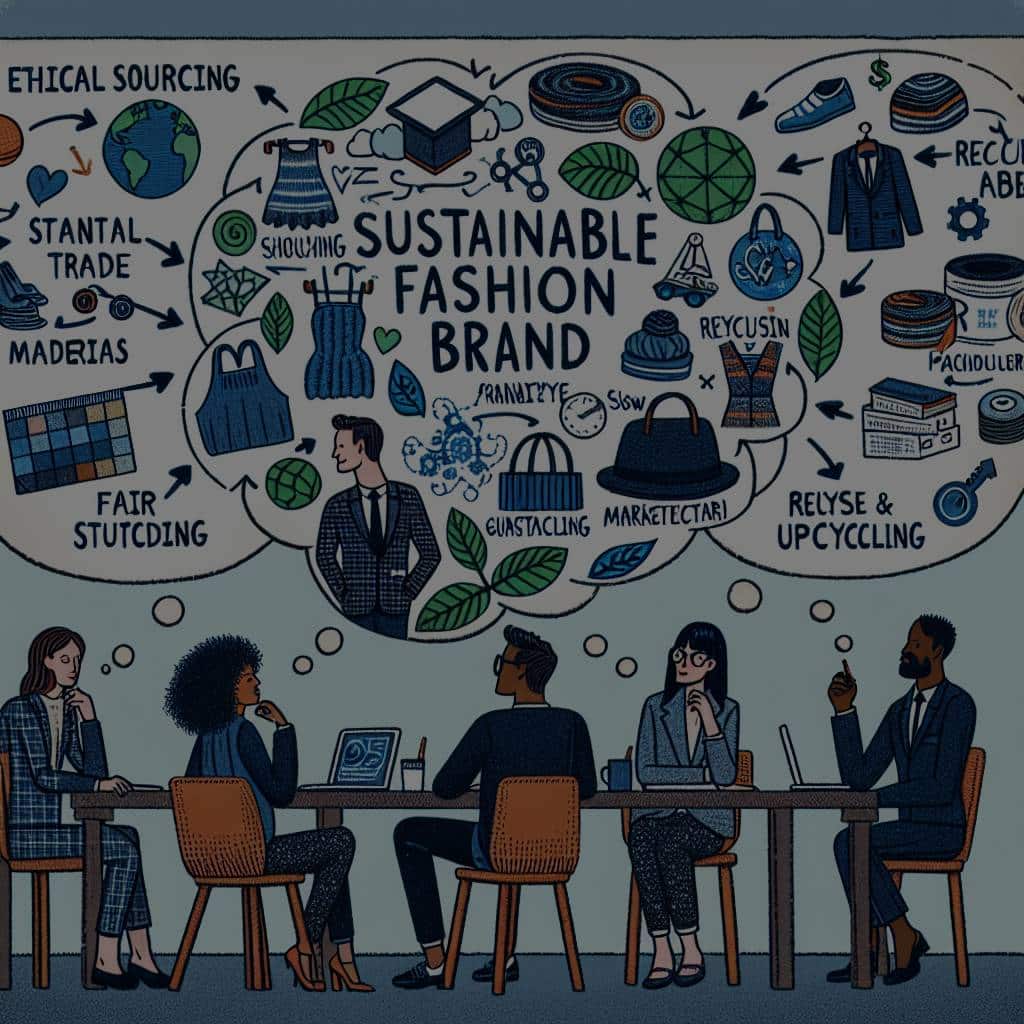The fashion industry, renowned for its glamour and creativity, is also infamous for its impact on the environment. Fashion is the second-largest water consumer worldwide, producing 20% of global wastewater and 10% of global carbon emissions. In a world awakening to the urgency of climate change, building a sustainable fashion brand is not just a luxury, but a necessity. This article aims to shed light on the best strategies to build a sustainable UK fashion brand, whether you are a budding fashion entrepreneur or an established business looking to shift towards more sustainable practices.
Rethinking the Supply Chain
A sustainable fashion brand begins with its supply chain. The sourcing of materials, manufacturing processes, and logistics are all key areas where the fashion industry leaves a substantial environmental footprint. Making a conscious shift towards sustainable practices in these areas can make a significant impact on a brand’s overall sustainability.
Dans le meme genre : How to Develop a Comprehensive Multi-Platform Content Distribution Strategy to Maximize Reach?
Sourcing of materials is the first step in the supply chain. Conventionally, fashion brands rely heavily on non-renewable resources, such as petroleum for synthetic fibers or rare minerals for dyes. A sustainable brand, on the other hand, should opt for renewable, organic, and recycled materials as much as possible. For instance, choosing organic cotton over traditional cotton can cut down water usage by 91% and energy usage by 45%.
Manufacturing processes are the next critical area. Traditional processes like dyeing, printing, and finishing are resource-intensive and often result in harmful effluents. Brands can adopt cleaner technologies, like waterless dyeing or digital printing, to mitigate this. In addition, they can partner with manufacturers that prioritize sustainability and adhere to environment-friendly practices.
Avez-vous vu cela : How Can UK Travel Agencies Maximize Revenue with Dynamic Pricing?
Logistics, often overlooked, are equally important. Transportation of goods contributes to a significant portion of the fashion industry’s carbon emissions. Brands can reduce their carbon footprint by opting for sea freight over air freight, consolidating shipments, and choosing carbon-neutral delivery options.
Encouraging Circular Fashion
The concept of circular fashion promotes resource efficiency by maximizing the life of products and minimizing waste. It encourages a shift from the traditional ‘make-use-dispose’ model to a more sustainable ‘make-use-reuse’ model.
Designing for longevity is a key aspect of encouraging circular fashion. By focusing on timeless designs and high-quality construction, brands can increase the lifespan of their products. Additionally, providing repair services can help maintain the product’s value and prolong its use.
Promoting second-hand sales is another effective strategy. Brands can organize buy-back schemes, where customers return their used items for resale or recycling. This not only prevents the products from ending up in landfills but also provides a more affordable way for consumers to engage with sustainable fashion.
Recycling is also a crucial part of circular fashion. Brands can invest in research and technology to develop effective recycling methods, turning old garments into new ones, or repurposing them into other products.
Transparency and Accountability
With growing consumer awareness around sustainability, honesty and transparency about a brand’s practices have become more important than ever. Brands that are upfront about their sustainability efforts are more likely to win the trust of their customers.
Transparency means not just providing information about where and how the products are made, but also who makes them and under what conditions. Brands can use technologies like blockchain to track and share the journey of their products from the farm to the store.
Accountability goes hand in hand with transparency. It involves setting clear, measurable sustainability goals and regularly reporting on the progress. Brands can use sustainability scorecards and certifications to communicate their performance to their stakeholders.
Educating and Engaging Consumers
While brands have a significant role to play in driving sustainable fashion, consumers are equally important. By educating and engaging consumers, brands can foster a culture of conscious consumerism.
Educating consumers about the environmental impact of their fashion choices can help them make more informed decisions. Brands can use their platforms to share insights about sustainable fashion, debunk myths, and challenge the status quo.
Engaging consumers can further amplify the impact. Brands can offer incentives for sustainable practices, like discounts for returning used items or purchasing recycled products. They can also encourage consumers to get involved in their sustainability initiatives, creating a sense of community and shared responsibility.
Collaborating for Change
The challenge of sustainability is not one that any brand can tackle alone. Collaboration – within the industry, with other sectors, and with policy-makers – is essential to accelerate the transition towards sustainable fashion.
Industry collaboration can take the form of shared research, joint initiatives, or collective agreements. For instance, several brands have joined forces under the Sustainable Apparel Coalition to develop the Higg Index – a tool to measure and compare the sustainability performance of different products.
Cross-sector collaboration can bring innovative solutions. The fashion industry can learn from and adapt sustainability practices from other sectors, like renewable energy or waste management.
Policy collaboration can help shape a conducive environment for sustainable fashion. Brands can engage with policy-makers to advocate for supportive regulations and incentives.
In conclusion, building a sustainable UK fashion brand requires a comprehensive approach, addressing everything from the supply chain to consumer engagement. With commitment, creativity, and collaboration, it is not just possible but also a promising path to a more sustainable and resilient fashion industry.
Championing Innovation and Technology
In the quest for sustainability, innovation and technology play pivotal roles. They present opportunities for brands to reduce their environmental footprint, increase efficiency, and offer sustainable solutions that meet the demands of the conscious consumer.
Sustainable technologies are a key component of this. For instance, waterless dyeing technologies can drastically cut down water usage in the dyeing process. Similarly, digital printing and laser cutting can reduce fabric waste in the design and manufacturing stage. These technologies not only contribute to sustainability, but they also often result in superior product quality, presenting a win-win scenario for both the brand and the consumer.
Innovative materials also play a crucial role. There’s a growing interest in bio-based and bio-degradable materials, such as bio-plastics and bio-fabrics, which offer a more sustainable alternative to petroleum-based synthetics. Recycled materials also offer a sustainable option, with technologies now available to recycle everything from cotton and polyester to nylon and rubber.
Technology-driven transparency is another growing trend. With the help of technologies like blockchain and RFID, brands can provide complete transparency about their supply chain, allowing consumers to trace the journey of their clothes from farm to wardrobe. This not only builds consumer trust, but it also allows brands to identify and address any sustainability issues in their supply chain.
Driving Sustainability Through Legislation and Policy
As much as individual brands can make a difference, systemic change in the fashion industry requires legislation and policy that support and incentivize sustainable practices. Government involvement not only sets the standard for what is acceptable but also shapes the playing field and encourages innovation and competition towards sustainability.
Regulations can put a limit on harmful practices, such as the use of certain chemicals, deforestation for fabric production, or the dumping of untreated wastewater. They can also mandate certain practices, like waste management or energy efficiency, pushing the industry towards more sustainable operations.
Incentives can encourage brands to go above and beyond these regulations. These can come in the form of tax breaks, grants, or preferential treatment for brands that demonstrate exceptional commitment to sustainability. They can also support research and development into sustainable technologies and materials.
Policy advocacy by brands themselves can also drive change. Many brands are already leading the way, engaging with policymakers, supporting sustainability-oriented policies, and even advocating for stricter regulation of their own industry.
Conclusion
The blueprint for a sustainable UK fashion brand calls for a multi-faceted approach that encompasses the supply chain, circular fashion, transparency, consumer engagement, innovation, technology, legislation, and policy. It requires commitment and dedication but also offers the potential for a more resilient and future-proof business. Through a combination of innovative practices, collaborative efforts, and a genuine commitment to change, UK fashion brands have the potential to lead the charge in creating a sustainable fashion industry, setting an example for the rest of the world to follow. While the path to sustainability may be challenging and complex, it is an investment in the future – a future where fashion is not just about looking good, but also doing good.





